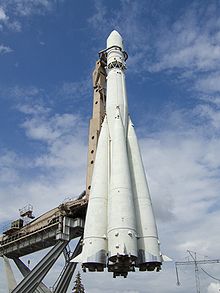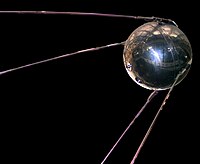The R-7 (Russian: Р-7) was the world's first true intercontinental ballistic missile, deployed by the Soviet Union during the Cold War from 1959 to 1968. To the West it was known by the NATO reporting name SS-6 Sapwood and within the Soviet Union by the GRAU index 8K71. In modified form, it launched Sputnik, the first artificial satellite, into orbit, and became the basis for the Soyuz space launcher and the Molniya, Vostok and Voskhod variants.
The widely used nickname for the R-7 launcher, "semyorka", simply means "the digit 7" in Russian.
 |
| SS-6 rocket. (NASA) |
 | ||||||||||||||||||||||||||||||||||||||
| R-7 8K72 "Vostok" permanently displayed at the Moscow Trade Fair at Ostankino; the rocket is held in place by its railway carrier, which is mounted on four diagonal beams that constitute the display pedestal. Here the railway carrier has tilted the rocket upright as it would do so into its launch pad structure -- which is missing for this display. | ||||||||||||||||||||||||||||||||||||||
 | |
| Major contractors | OKB-1, Soviet Ministry of Radiotechnical Industry |
|---|---|
| Mission type | Atmospheric studies |
| Satellite of | Earth |
| Orbits | 1,440 |
| Launch date | 19:28:34, October 4, 1957 (UTC) (22:28:34 MSK) |
| Launch vehicle | Sputnik rocket |
| Mission duration | 3 months |
| Orbital decay | 4 January 1958 |
| COSPAR ID | 1957-001B |
| Homepage | NASA NSSDC Master Catalog |
| Mass | 83.6 kg (184.3 lb) |
| Orbital elements | |
| Semimajor axis | 6,955.2 km (4,321.8 mi) |
| Eccentricity | 0.05201 |
| Inclination | 65.1° |
| Apoapsis | 7,310 km (4,540 mi) from centre, 939 km (583 mi) from surface |
| Periapsis | 6,586 km (4,092 mi) from centre, 215 km (134 mi) from surface |
| Orbital period | 96.2 minutes |
Sputnik 1 (Russian: "Спутник-1" Russian pronunciation: [ˈsputʲnʲək], "Satellite-1", ПС-1 (PS-1, i.e. "Простейший Спутник-1", or Elementary Satellite-1)) was the first Earth-orbiting artificial satellite. It was launched into an elliptical low Earth orbit by the Soviet Union on 4 October 1957, and was the first in a series of satellites collectively known as the Sputnik program. The unanticipated announcement of Sputnik 1's success precipitated the Sputnik crisis in theUnited States and ignited the Space Race within the Cold War. The launch ushered in new political, military, technological, and scientific developments. While the Sputnik launch was a single event, it marked the start of the space age.
Apart from its value as a technological first, Sputnik also helped to identify the upper atmospheric layer's density, through measuring the satellite's orbital changes. It also provided data on radio-signal distribution in the ionosphere. Pressurized nitrogen, in the satellite's body, provided the first opportunity formeteoroid detection. If a meteoroid penetrated the satellite's outer hull, it would be detected by the temperature data sent back to Earth.
Sputnik 1 was launched during the International Geophysical Year from Site No.1, at the 5th Tyuratam range, in Kazakh SSR (now at the Baikonur Cosmodrome). The satellite travelled at 29,000 kilometers (18,000 mi) per hour, taking 96.2 minutes to complete an orbit, and emitted radio signals at 20.005 and 40.002 MHz which were monitored by amateur radio operators throughout the world.The signals continued for 22 days until the transmitter batteries ran out on 26 October 1957. Sputnik 1 burned up on 4 January 1958, as it fell from orbit upon reentering Earth's atmosphere, after travelling about 60 million km (37 million miles) and spending 3 months in orbit.


Good review somil stay updated with my blog http://how-2-earnmoneyonline.blogspot.com for more about blogging tips and earn money online.......
ReplyDelete